10 Essential Features of Medical Inventory Management Software

10 Essential Features of Medical Inventory Management Software
Overview
This article focuses on the essential features of medical inventory management software that enhance operational efficiency and patient care. Key functionalities include real-time tracking, EHR integration, and mobile accessibility. These features collectively enable healthcare organizations to optimize inventory management, reduce waste, and ensure timely access to medical supplies.
What advantages do these features offer? Real-time tracking allows for immediate visibility into inventory levels, helping to prevent shortages and overstock situations. EHR integration streamlines the ordering process, ensuring that medical supplies are replenished as needed, while mobile accessibility empowers staff to manage inventory on the go.
Ultimately, these functionalities lead to improved patient outcomes. By optimizing inventory management, healthcare organizations can provide timely care, reduce delays, and enhance the overall patient experience. How can your organization leverage these features to improve its operations? Consider the implications of adopting such software in your practice.
Introduction
In the fast-paced realm of healthcare, effective inventory management can significantly impact patient care, preventing critical shortages. Medical inventory management software stands out as an essential tool, offering features that streamline operations and enhance decision-making processes. But with so many options available, how can healthcare organizations pinpoint the most vital functionalities to implement? This article explores ten essential features of medical inventory management software, illustrating how they can transform inventory practices and ultimately improve patient outcomes.
Initial Data Offering: Comprehensive Medical Inventory Management Solutions
The Initial Data Offering (IDO) serves as a robust platform for managing medical resources, specifically tailored to meet the unique needs of healthcare professionals through medical inventory management software. What if you could streamline your medical supply management? By leveraging AI-driven business intelligence alongside high-quality datasets, IDO empowers organizations to efficiently oversee their medical inventory management software, reduce waste, and ultimately enhance patient care.
One of the standout features of IDO is its comprehensive data solutions. This focus allows medical facilities to make informed decisions regarding stock levels, supplier relationships, and regulatory compliance by utilizing medical inventory management software. Imagine the impact of having accurate data at your fingertips! Such insights not only improve operational efficiency but also lead to better outcomes for patients.
In summary, the IDO platform is not just about managing resources; it’s about transforming how medical practitioners operate with medical inventory management software. By adopting this innovative approach, healthcare organizations can ensure they are well-equipped to meet the demands of their patients while optimizing their resources effectively.
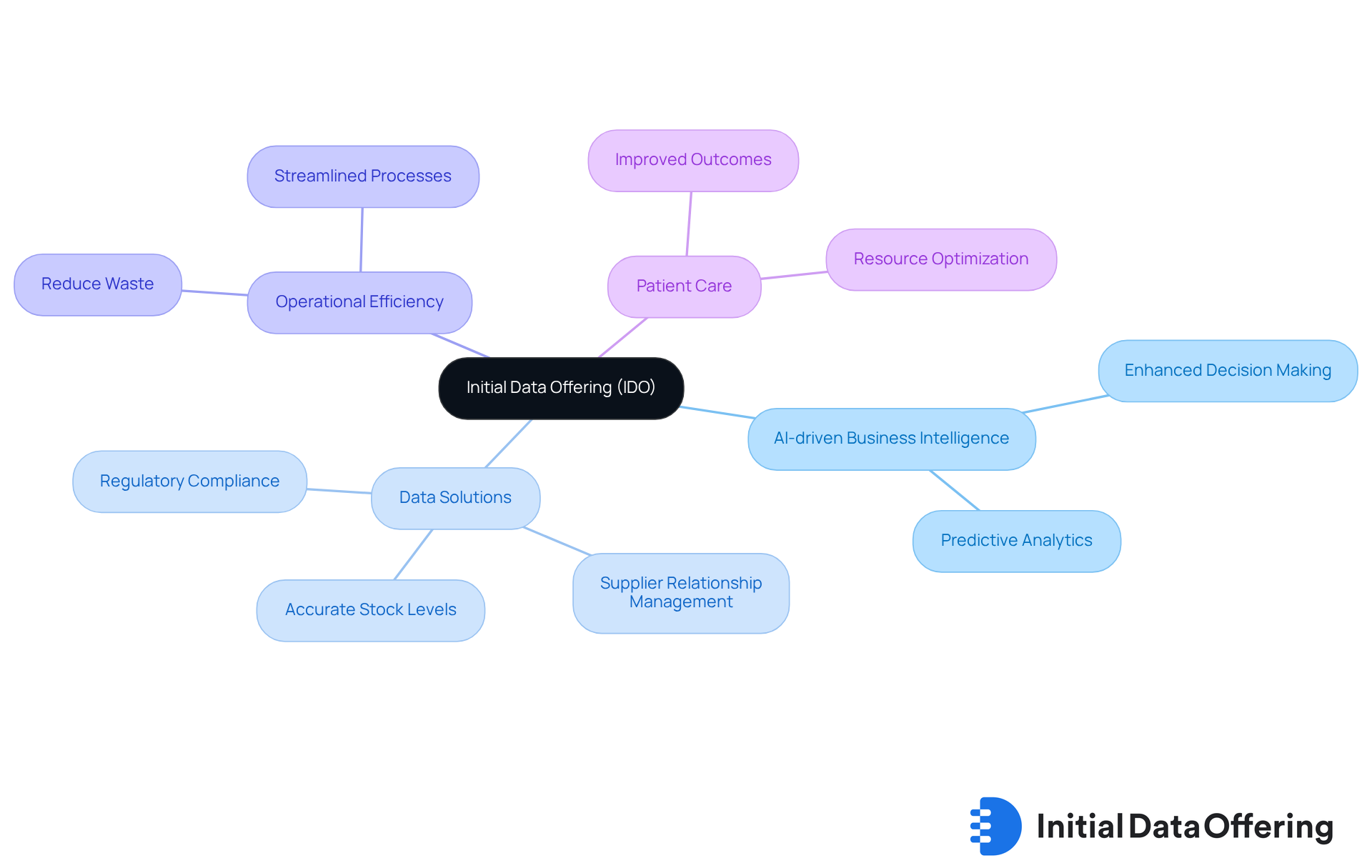
Real-Time Tracking: Enhance Inventory Accuracy and Efficiency
The medical inventory management software provides real-time tracking capabilities that empower healthcare providers to monitor stock levels continuously, ensuring essential supplies are available when needed. This proactive approach significantly reduces the risk of stockouts, which can jeopardize patient care, while also preventing overstock situations that lead to waste. By leveraging real-time data, organizations can enhance operational efficiency and make informed purchasing decisions based on current stock levels.
For example, Kanto Medical Center in Tokyo adopted an automatic identification system that improved accuracy and turnaround times, effectively addressing the challenges posed by an increase in surgeries. Similarly, Grady Memorial Hospital's use of active RFID technology for real-time location tracking of medical equipment has resulted in better asset utilization and fewer incidents of lost equipment. These cases illustrate the substantial impact of medical inventory management software and real-time stock monitoring on medical operations, ultimately leading to improved patient outcomes and streamlined processes.
Moreover, tracking entire instrument sets instead of individual instruments is increasingly recognized as essential for infection control. RFID technology has demonstrated enhanced efficiencies, automated data transfer, and real-time location tracking, all crucial for the effective use of medical inventory management software in managing surgical instrument sets and equipment supplies. As Tori Whitacre Martonicz aptly states, "Building a culture of sharps safety requires more than just tools." This highlights the need for comprehensive tracking solutions that address the complexities of surgical devices and staffing challenges in medical environments.
![]()
EHR Integration: Streamline Data Management and Patient Care
Integrating medical inventory management software with EHR systems offers a significant feature: seamless information exchange between care providers and stock oversight. This integration allows medical providers to access real-time data on individual patient needs. As a result, they can manage stock levels more efficiently.
What does this mean for healthcare organizations? By streamlining data handling, they can enhance patient care, reduce errors, and improve overall operational efficiency. Imagine a scenario where a provider can instantly see what supplies are needed for a patient, ensuring timely treatment without the risk of stockouts.
In conclusion, the integration of these systems, including medical inventory management software, not only optimizes inventory management but also directly contributes to better patient outcomes. Organizations that embrace this technology position themselves to deliver higher quality care while operating more effectively.
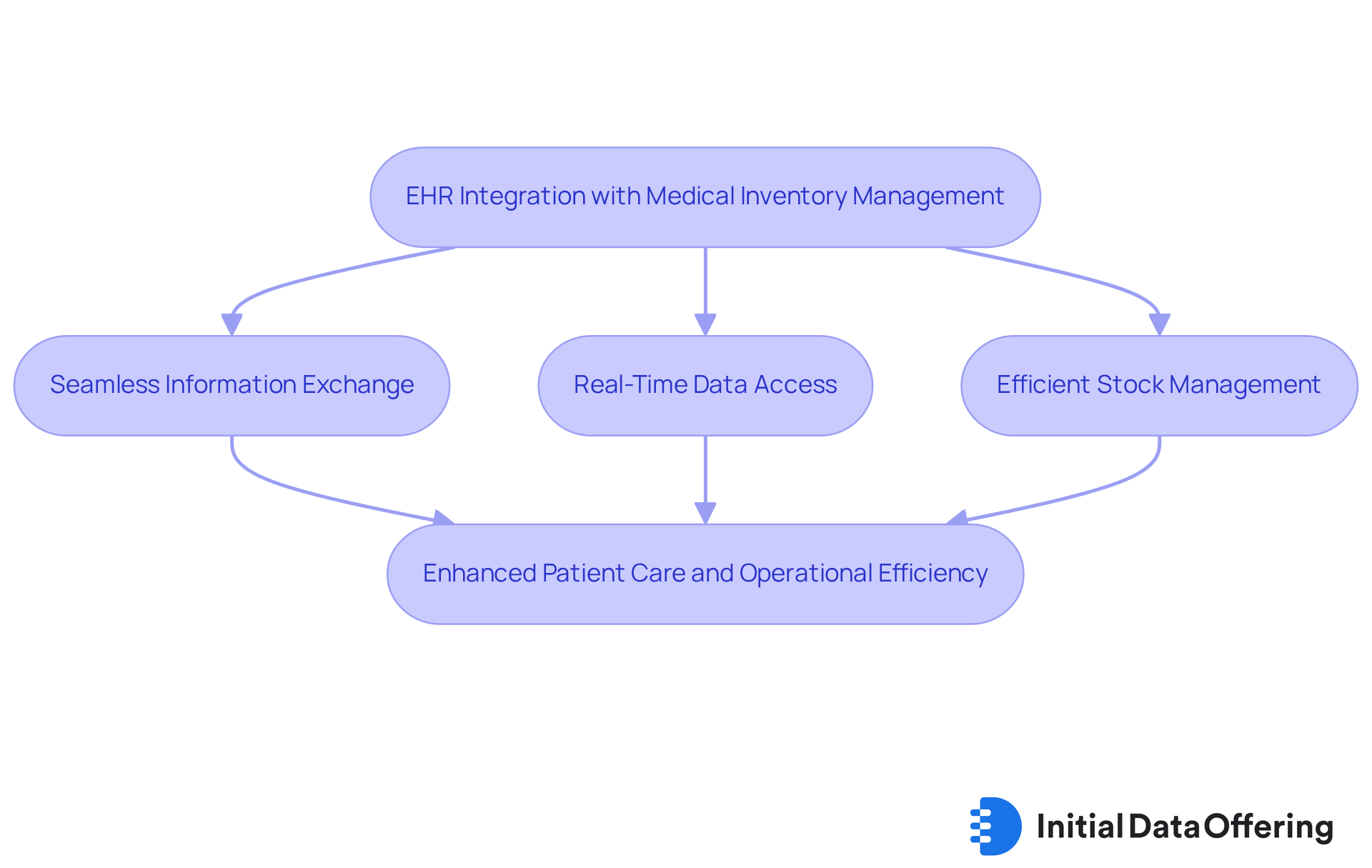
Multi-Location Support: Manage Inventory Across Multiple Facilities
For healthcare organizations with multiple facilities, managing stock can be simplified through the use of medical inventory management software. Medical inventory management software provides a key feature of centralized supervision through its multi-location support in stock control. This allows organizations to monitor stock levels across all locations effectively.
The advantages of this centralized approach are significant:
- It helps reduce discrepancies in stock levels
- Ensures consistent supply across facilities
- Facilitates better coordination among them
These benefits ultimately lead to improved patient care and enhanced operational efficiency.
How can your organization leverage this feature? By implementing medical inventory management software for centralized stock control, you can streamline operations and focus more on delivering quality care. Consider the impact of consistent supply levels on your facility's performance and patient satisfaction.
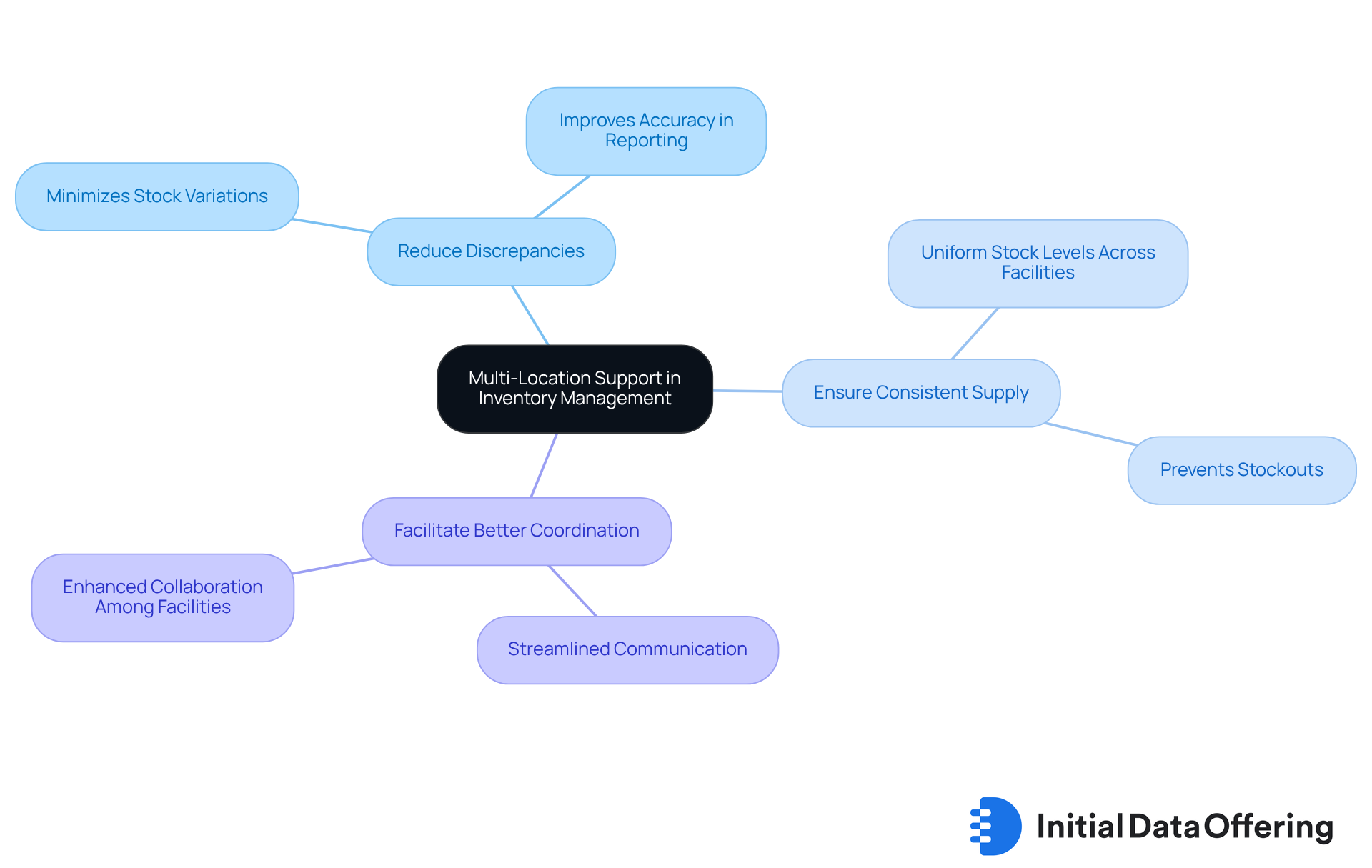
Barcode and RFID Support: Automate Inventory Tracking
Barcode and RFID assistance in medical stock control software offers a significant feature: automation of the tracking process. This technology enables swift and precise counts of supplies, which is crucial in a fast-paced medical environment. By scanning items upon receipt or utilization, medical providers can effectively reduce manual mistakes. This advantage not only streamlines management processes but also enhances overall efficiency.
The benefits of this automation are substantial. It saves valuable time, allowing healthcare professionals to focus on patient care rather than inventory management. Moreover, it ensures that stock records are always current, which is vital for informed decision-making and optimal resource allocation. How often have you faced challenges due to outdated stock information? With automated systems, those issues can become a thing of the past.
In conclusion, integrating barcode and RFID technology into medical stock control not only simplifies inventory management but also supports better operational outcomes. By embracing these advancements, medical providers can enhance their service delivery and ensure that resources are utilized effectively.

Forecasting and Demand Planning: Optimize Inventory Levels
Forecasting and demand planning capabilities are essential for healthcare organizations aiming to optimize their stock requirements. By analyzing historical data and trends, providers can accurately predict their inventory needs. This proactive approach not only ensures that the right supplies are available but also prevents overstocking, which can lead to waste.
What if your organization could enhance its responsiveness to patient needs? By examining previous usage trends, healthcare providers can fine-tune their stock levels, striking a balance between availability and efficiency. This not only reduces waste but also significantly improves the ability to meet patient demands effectively.
In conclusion, leveraging forecasting and demand planning not only streamlines inventory management through medical inventory management software but also enhances overall patient care. By adopting these strategies, healthcare organizations can position themselves to respond swiftly and effectively to the evolving needs of their patients.
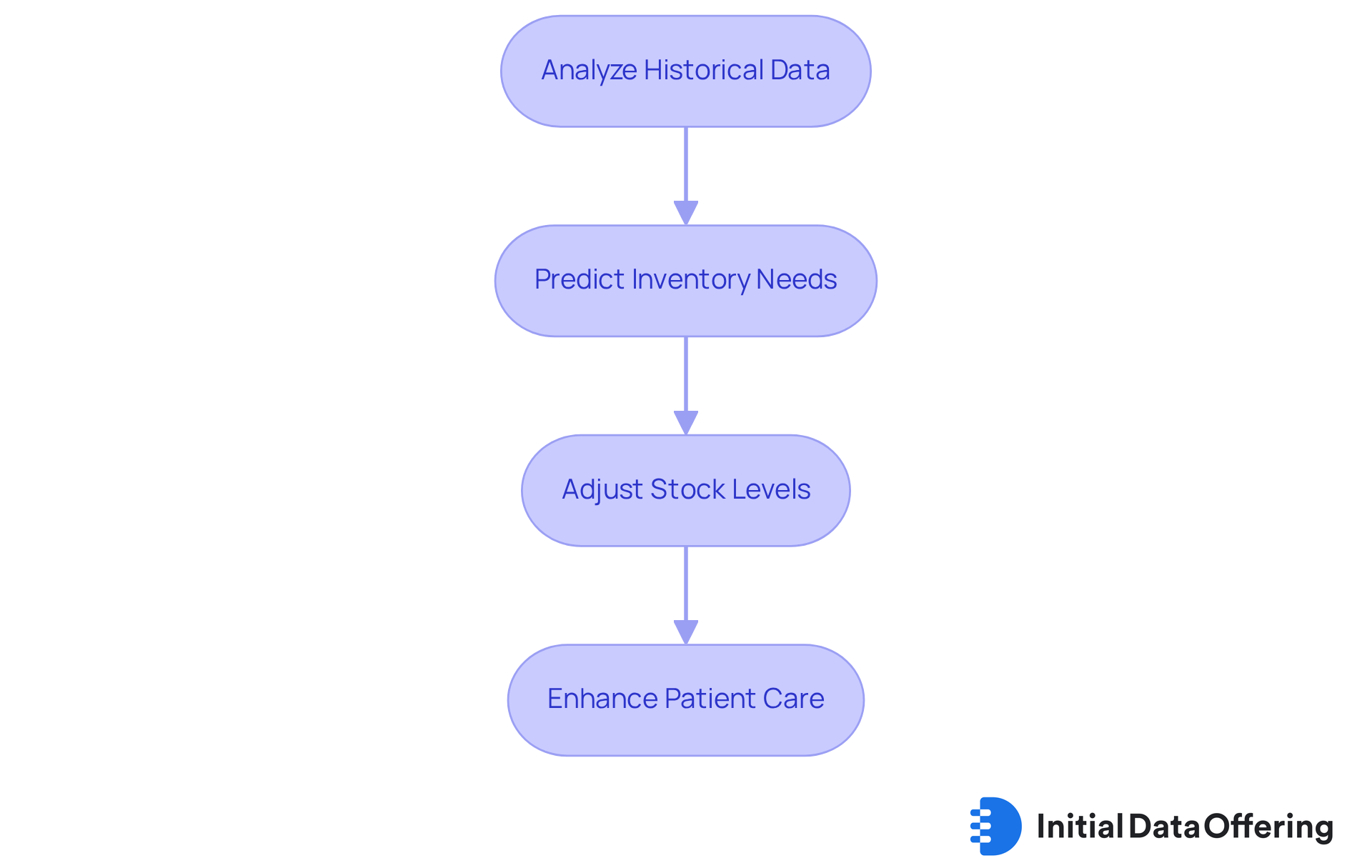
Supplier Management: Strengthen Vendor Relationships
Strong supplier oversight capabilities in medical inventory management software are essential for organizations looking to maintain robust relationships with their vendors. By effectively tracking supplier performance, pricing, and delivery times, organizations can negotiate better terms and ensure a reliable supply chain. This proactive approach not only enhances stock reliability but also leads to significant cost reductions and improved service quality.
Consider the advantages of such oversight: organizations can identify underperforming suppliers and address issues before they escalate. This not only fosters accountability but also encourages suppliers to meet or exceed expectations. The benefits are clear: a more reliable supply chain translates to fewer disruptions and enhanced operational efficiency.
How can your organization leverage these capabilities? By implementing strong supplier oversight and utilizing medical inventory management software, you can create a more resilient supply chain that supports your operational goals. In doing so, you not only improve your bottom line but also enhance the quality of service you provide to your customers.
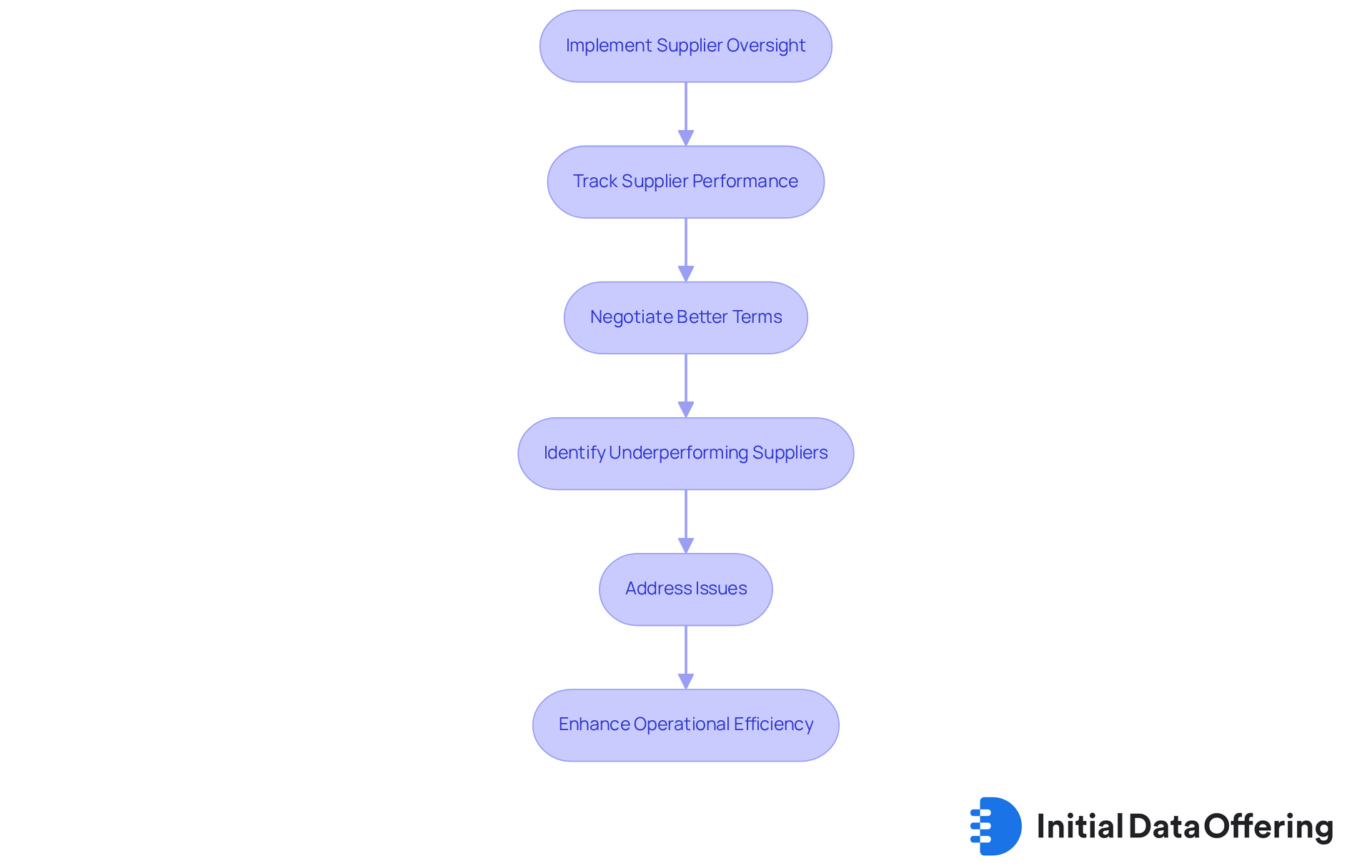
Mobile Accessibility: Manage Inventory Anytime, Anywhere
Mobile accessibility in medical inventory management software offers a crucial feature for medical professionals: the ability to monitor stock from virtually anywhere, at any time. This capability is particularly advantageous in dynamic environments where rapid decision-making is essential. By providing access to real-time stock information on mobile devices, organizations can significantly enhance their responsiveness, ensuring they are always prepared to meet client needs.
For instance, medical facilities that have adopted mobile stock management systems have reported a notable decrease in both shortages and excess supplies. This improvement stems from their ability to monitor usage trends and predict demand, which directly contributes to enhanced safety for individuals receiving care. A medical expert from St. Mary’s Hospital noted, 'We employed medical inventory management software as a cloud-based stock control system to monitor surgical supplies and medications,' highlighting how mobile technology can streamline operations and facilitate quicker adjustments to stock levels based on urgent needs.
Moreover, medical inventory management software with automated reordering features accessible via mobile platforms helps maintain optimal stock levels, thereby reducing the risk of stockouts and waste. However, it’s important to recognize that challenges such as integration issues and the necessity for staff training can complicate the implementation of these systems.
This adaptability not only supports effective stock control but also fosters a proactive approach to medical service provision, ultimately leading to improved care outcomes for individuals. How might your organization benefit from implementing such mobile solutions? Consider the potential for enhanced efficiency and safety in your operations.
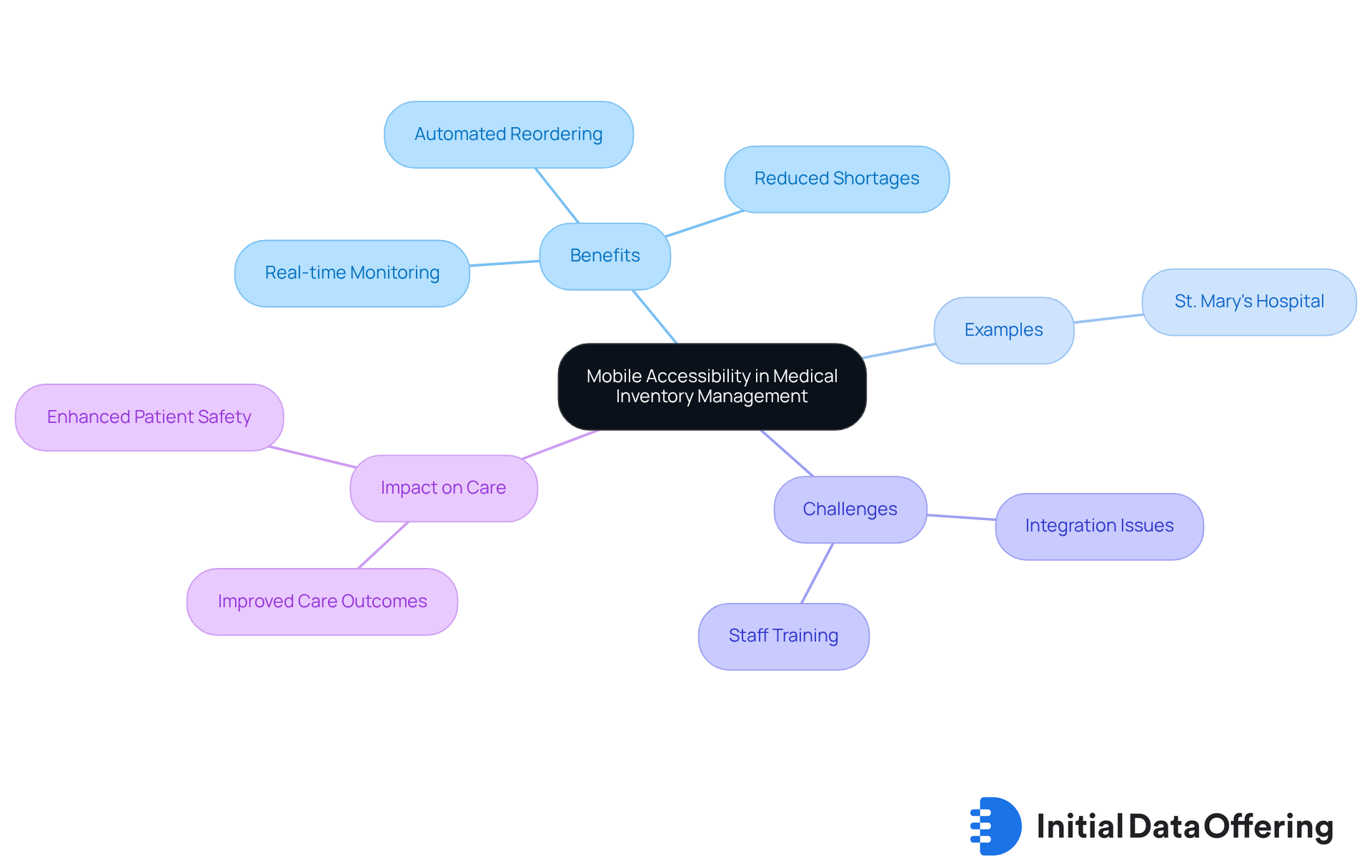
Expiration Date Tracking: Ensure Safety and Compliance
Monitoring expiration dates is a crucial feature of medical inventory management software. It allows medical providers to effectively track the shelf life of their products. By keeping a close eye on expiration dates, organizations can avoid using outdated items. This not only safeguards patient safety but also ensures compliance with healthcare regulations.
The advantages of this proactive approach are significant. It protects patients from potential harm and enhances the overall quality of care provided. But how can organizations implement this effectively? Consider integrating automated alerts within your inventory system to notify staff of upcoming expirations. This simple step can make a substantial difference in maintaining safety standards.
In conclusion, expiration date monitoring is more than just a feature; it’s a vital component of healthcare management that can be effectively managed with medical inventory management software. By prioritizing this practice, organizations can improve patient outcomes and uphold the integrity of their services. Are you ready to take the necessary steps to enhance your inventory management?
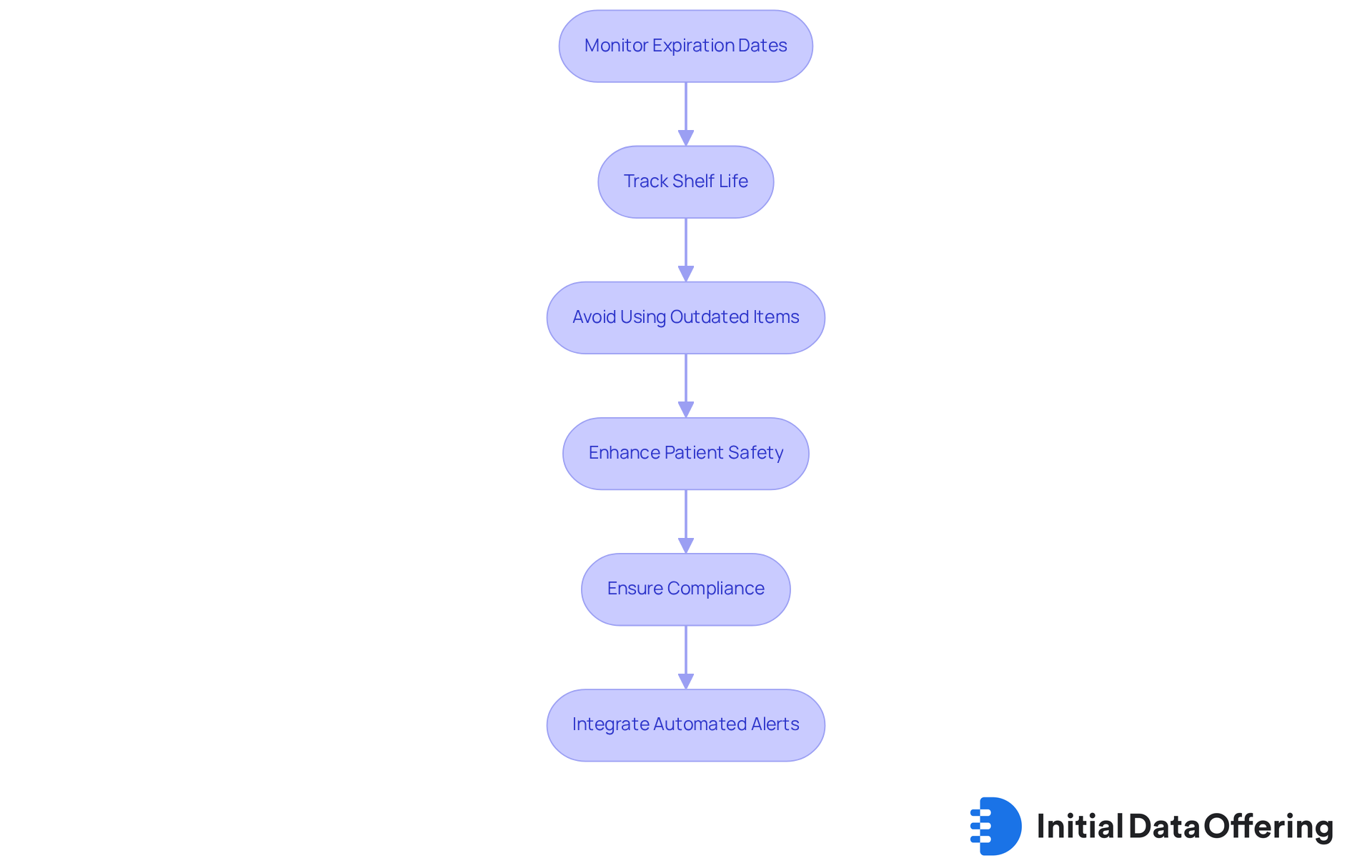
Audit Trails and Compliance: Maintain Regulatory Standards
Audit trails in medical inventory management software provide a comprehensive record of transaction activities. This feature is crucial for organizations aiming to maintain compliance with regulatory standards. By tracking who accessed or modified inventory records, healthcare providers can demonstrate accountability and transparency during audits.
What does this mean for your organization? It means that not only does this feature support compliance efforts, but it also enhances overall operational integrity. This reduces the risk of errors and significantly improves patient safety.
Incorporating audit trails into your medical inventory management software can lead to a more reliable system. As a result, healthcare providers can foster trust with stakeholders and ensure that they are prepared for any regulatory scrutiny.
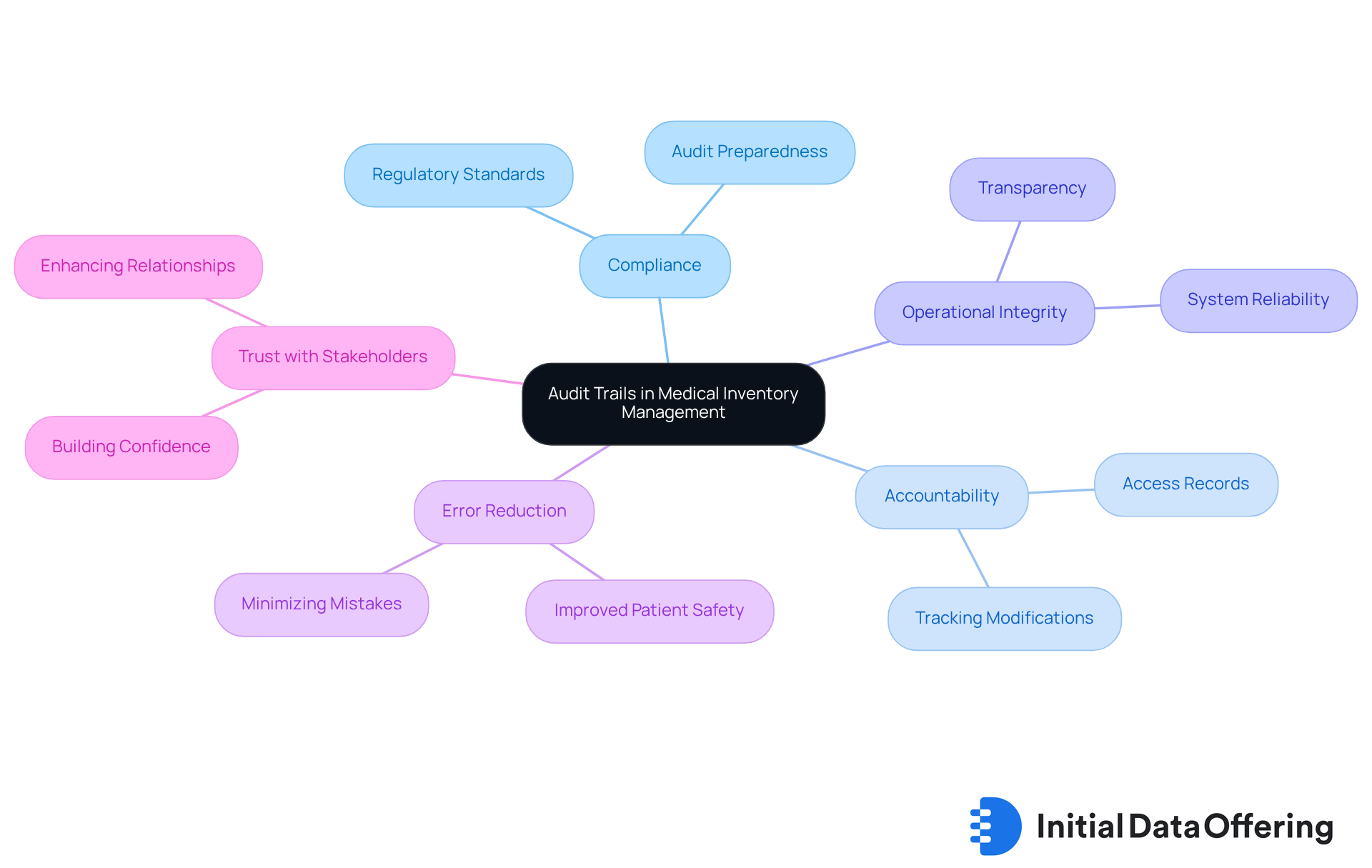
Conclusion
The integration of essential features in medical inventory management software is crucial for healthcare organizations aiming for operational excellence and improved patient care. By leveraging advanced technologies like real-time tracking, EHR integration, and mobile accessibility, organizations can significantly enhance their inventory management processes. This transformation not only streamlines operations but also ensures that healthcare providers have the necessary resources to meet patient needs promptly.
Key features such as:
- Multi-location support for centralized oversight
- Automated tracking through barcode and RFID technology
- Proactive demand planning
are vital. These components help mitigate risks associated with stockouts and overstocking, ultimately leading to better patient outcomes and operational efficiency. Additionally, the focus on expiration date tracking and audit trails highlights the importance of compliance and safety in healthcare settings.
In conclusion, adopting these features goes beyond merely improving inventory management; it fosters a healthcare environment where patient safety and care quality are paramount. Organizations should evaluate their current systems and consider integrating these innovative solutions. How can these advancements position them to navigate the complexities of healthcare delivery effectively? By embracing these tools, they can ensure they are always prepared to meet the evolving demands of their patients.
Frequently Asked Questions
What is the Initial Data Offering (IDO)?
The Initial Data Offering (IDO) is a platform designed for managing medical resources, specifically tailored to healthcare professionals through medical inventory management software. It leverages AI-driven business intelligence and high-quality datasets to help organizations efficiently oversee their medical inventory, reduce waste, and enhance patient care.
How does IDO improve decision-making in medical inventory management?
IDO provides comprehensive data solutions, allowing medical facilities to make informed decisions regarding stock levels, supplier relationships, and regulatory compliance. Access to accurate data helps improve operational efficiency and leads to better patient outcomes.
What are the benefits of real-time tracking in medical inventory management?
Real-time tracking capabilities allow healthcare providers to continuously monitor stock levels, ensuring essential supplies are available when needed. This proactive approach reduces the risk of stockouts and prevents overstock situations, enhancing operational efficiency and informed purchasing decisions.
Can you provide examples of organizations that have successfully implemented real-time tracking?
Yes, Kanto Medical Center in Tokyo improved accuracy and turnaround times by adopting an automatic identification system. Grady Memorial Hospital used active RFID technology for real-time location tracking of medical equipment, resulting in better asset utilization and fewer lost equipment incidents.
Why is tracking entire instrument sets important for infection control?
Tracking entire instrument sets instead of individual instruments is essential for infection control. RFID technology enhances efficiencies, automates data transfer, and provides real-time location tracking, which are crucial for effectively managing surgical instrument sets and equipment supplies.
What is the significance of EHR integration with medical inventory management software?
Integrating medical inventory management software with EHR systems allows for seamless information exchange between care providers and stock oversight. This integration enables providers to access real-time data on patient needs, enhancing patient care and reducing errors.
How does EHR integration contribute to better patient outcomes?
By streamlining data handling and enabling timely access to necessary supplies, EHR integration helps healthcare organizations manage stock levels more efficiently. This leads to improved patient care and operational efficiency, ultimately resulting in better patient outcomes.